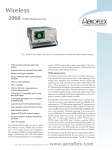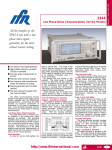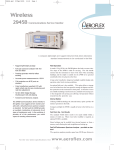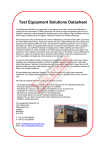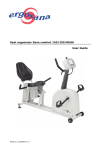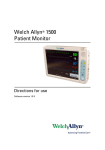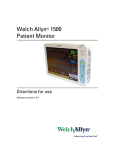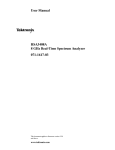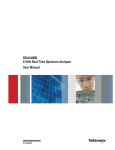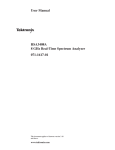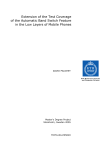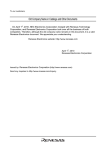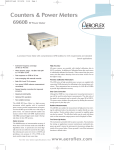Download Aeroflex/IFR 2967 Datasheet
Transcript
2967iss13.qxd 01/Dec/2004 10:09 Page 1 Wireless 2967 GSM 900/1800/1900 Radio Test Set High Performance GSM 900/1800/1900 and analog test solution with digital test incorporating Dual Band functionality. This product can be used in conjunction with PhoneTest software • Supports GSM 900/1800/1900 (GSM) and Phase 2 GSM measurements • Available with PhoneTest software suite • Power and phase profile plots for normal and access bursts to aid diagnostics • Full range of BER/RBER/FER measurements for receiver testing • Dual band functionality • Manual, GO/NO GO and fully programmable testing • Supports AMPS, TACS, NMT and MPT 1327 trunking • Full range of analog instrumentation The 2967 Radio Test Set supports all the protocols required to perform measurements on GSM 900/1800/1900 MHz systems. In addition, it supports analog cellular standards TACS, AMPS, NMT and the world-wide trunking systems based on MPT 1327. Based on ETSI GSM11.10 recommendations, the 2967 tests all the essential RF, audio and DC parameters quickly and easily in both Service and Production environments. Unlike GSM only radio test sets, the 2967 includes a host of RF instrumentation and analog/digital facilities which are invaluable for performing diagnostics, radio alignment and parametric tests. High-speed testing is ensured by use of pre-programmed test sequences, fully user configurable for depth of test, running on a multi-processor test platform. Further speed enhancements are obtained by performing simultaneous TX or RX measurements over a specified number of bursts using remote control commands. GSM 900 Phase two testing is fully supported in the 2967. Extensive GSM Functionality The 2967 emulates a GSM 900/1800/1900 base station allowing mobiles to be tested in the same way that they operate on a real system without user knowledge of manufacturer specific test modes. Network simulation is especially useful when checking for configuration problems on mobiles. Transmitter tests measure power, peak and RMS phase error, frequency error and timing error, all as specified in GSM11.10. Graphical displays, with fast update rates, show power profile and phase profile against the relevant GSM masks, for both shortened and normal bursts, to aid radio alignment. Receiver testing covers all classes of BER, RBER and FER readings, and automatic sensitivity measurement is also provided. New system features have been added to test additional terminal facilities, IMSI detach, Cell Barring and Minimum RF level for Access. The 2967 covers the Phase 2 frequency plan (E-GSM) and supports the lower power levels (PL16-PL19). Dual Band Functionality Multi-band capability has been added to the test functions of the 2967, allowing full testing of multi-band mobiles in manual test, autorun and remote, including PhoneTest applications. Registration and calls to and from the mobile can be tested in the GSM 900 and 1800/1900 bands with handoff carried out from band to band. For the very latest specifications visit www.aeroflex.com 2967iss13.qxd 01/Dec/2004 10:09 Page 2 Spectrum Analysis The inbuilt RF spectrum analyzer allows fast, high resolution analysis of signals applied either directly to the RF ports or off-air via an antenna. It carries many features only usually found on stand-alone analyzers, such as full span, selectable resolution bandwidth filters and two steerable markers. The 2967 produces print outs at the touch of a key, providing the terminal information and test results in a concise form. ‘Brief Test’, for example, gives a three channel summary in a single page. The pass/fail count is given at the bottom of the page so good radios can be verified quickly and bad ones can be identified. The 2967 print-outs also include the instrument serial number as well as time/date stamping, and can also be annotated with the Company name and User name for quality control. Printouts can be stored to a standard PCMCIA2 memory card. Manual and Automatic Operation The 2967 User Interface offers ready access to many sophisticated functions. The instrument extends the original test set interface established by the 2955 into the world of digital communications. The large bright, high resolution screen and the 22 associated softkeys on the front panel have significant benefits in terms of user comfort, and hence efficiency in Manual test modes. The tracking generator facility (with offset tracking) is provided for RF module characterization. With a useable frequency range of 100 kHz to 1 GHz and 1.3 GHz to 2.2 GHz, the spectrum analyzer supports IQ modulator alignment and the testing of internal local oscillators and IF systems. IQ alignment tests are recommended on most popular GSM terminals. Advanced GSM Measurements The 2967 performs advanced GSM measurements for detailed fault diagnosis in production and advanced service centre environments. For radios that refuse to register or go into conversation, the 2967’s capability to analyze the access (RACH) bursts is invaluable. All transmitter measurements are automatically triggered on these bursts to help the user isolate problems. An advanced Mobile Tuning Range Test Capability (Warping) is also available. With this facility (Option 22) the BCCH (Broadcast Control Channel) frequency and data rate can be varied in controlled steps, enabling mobiles with poor reference oscillators to be identified in Manual and Automatic modes of operation. For complete versatility, the 2967 can be used to transmit or receive at any frequency within the 10 MHz to 1 GHz band, 1.709 to 1.991 GHz Rx and 1.709 to 1.991 GHz Tx frequencies and radios can be tested in test modes, without signaling and synchronization. For automatic testing, the 2967 includes four built-in test programs ranging from simple call processing to comprehensive performance testing. These test programs are easy to configure – individual tests can be turned on and off, limits changed and averaging periods optimized. For complete flexibility, the 2967 can be programmed through MI-BASIC. PhoneTest The 2967 can be enhanced by using PhoneTest, which is a PC based solution running on Windows 95/98 or Windows NT, for GSM 900/1800/1900 testing. PhoneTest brings a new dimension to Radio Test Set applications by introducing more than just the ability to test digital cellular handsets. The PhoneTest suite of programs comprises four component parts, a control driver package, PhoneTest-Repair, PhoneTest-Manager and PhoneTest-Exchange, providing a complete service workshop logistics solution. Proven Analog Cellular Testing For analog cellular testing IFR is established as the de facto industry standard. The 2967 provides the fundamental measurements required (e.g. broadband power, FM deviation, SINAD) and a range of advanced diagnostic facilities, such as the unique 40 kHz FFT analyzer and 500 kHz oscilloscope. TACS, AMPS and NMT come as options which support most country variants. Test Program Generation Made Easy The internal MI-BASIC controller allows users to write programs using the internal automatic test routines and the standard instrument functions and measurements. Conventional BASIC functions are supported such as mathematical operations, branching and looping. Display of Mobile Reports The 2967 reports equipment and subscriber details during registration and call placement. The IMSI and IMEI are displayed, as are power-class, revision (Phase 1 or Phase 2), and encryption capability (A5/1 or A5/2), frequency and short message service capabilities. Programs can be written using a standard PC text editor and downloaded, via RS-232, to the test set. The program then remains in the instrument even after switch off. A program loaded into the instrument can be copied onto a memory card and then transferred quickly and easily to another unit. 2967iss13.qxd 01/Dec/2004 10:09 Page 3 APPLICATIONS audio analyzer aid rapid fault diagnosis. Production Go/No Go Testing For the production environment the 2967 can be controlled fully over GPIB or RS-232. These interfaces come as standard. Versatility is paramount; all of the internal test sequences can be modified easily by the user – particular tests can be selected/deselected, parameters and limits can be adjusted to suit. Go/No Go testing is essential to maintain quality in production, distribution and service. In this application, test speed and ease-of-use are key; the 2967 delivers on both counts. For GSM 900/1800/1900, commands are available to perform and read back the results of either all the TX tests or all the RX tests simultaneously giving a significant time saving. For more involved testing the unit is fully programmable via the internal MI-BASIC interpreter, allowing the user to write custom test programs. Via this programming language the user has access to all of the internal tests and more: RS-232 read/write can be used to control a radio in test modes and read or write calibration data; four logic controls on the rear of the instrument can be used to drive mechanical actuators. Programs downloaded into the instrument can be copied onto the memory card then quickly and easily transferred to other units. SPECIFICATION GENERAL INFORMATION Certain characteristics are shown as typical. These provide additional information for use in applying the instrument but they are unwarranted. (Applies to version 7.00 and above) RF SIGNAL GENERATOR DIGITAL SIGNAL GENERATOR FREQUENCY Range 800 MHz to 1 GHz Alignment Most modern cellular phones, whether analog or digital, contain few if any mechanical trimmers – most calibration, or ‘phasing’, is carried out electrically via the keypad or a local PC. For calibration, the 2967 shows all of the fundamental measurements on the screen at the same time. Rapid update rates simplify alignment. Calibrating the radio for power, frequency and modulation accuracy is straight-forward using the instrument’s bar charts and graphical displays. 1709 MHz to 1991 MHz Resolution 1 Hz to 1 GHz 2 Hz to 1991 MHz Indication 10 digit display Setting Keyboard entry, delta increment/decrement function and rotary variable control Accuracy As frequency standard OUTPUT LEVEL Range One-port Dx modes: MI-BASIC provides full access to the RS-232 port and all measurement functions, making the standard instrument suitable for closedloop alignment applications. N-Type socket: –135 dBm to –45 dBm TNC socket: –135 dBm to –25 dBm Two-port Dx modes: N-Type socket: –135 dBm to –35 dBm TNC socket: –135 dBm to –15 dBm Resolution Service In the field, many faults are simple connector, antenna or battery problems. These can often be identified visually. To locate more complex faults, e.g. unable to register, those that result from component or solder joint failure, sophisticated test tools are required. The 2967 TCH mode allows phones to be tested in test modes. Under Manual mode the instrument behaves as a signal generator and, at the same time, a ‘free-running’ receiver. No synchronization between the uplink and downlink is required. Standard features, not available on GSM specific test sets, such as the spectrum analyzer, oscilloscope, multimeter and the unique FFT For the very latest specifications visit 0.1 dB Indication 4 digits plus sign (dBm, dB µV, µV, mV PD/EMF) Accuracy N-Type socket single port duplex ±1.5 dB ±1.0 dB over the temperature range 15 to 35°C www.aeroflex.com 2967iss13.qxd 01/Dec/2004 10:09 Page 4 Sub Harmonics 1709 to 1991 MHz <-40 dBc GMSK MODULATION – INTERNAL Frequency Range 800 MHz to 1 GHz, useable to 1.15 GHz 1.805 to 1.88 GHz (GSM 1800) 1.930 to 1.99 GHz (GSM 1900) Bt 0.3 Phase Error (in useful part of burst) Dynamic Range 0 dBm to +47 dBm Power Profile Dynamic Range 44 dB Power Reading Average power over useful part of burst Burst Type Normal/Access Indication Units dBm <1° RMS Resolution <4° peak 0.1 dB BER METER Indication 3 digits and bar chart with peak hold Types BER Class I BER Class II RBER Class Ib RBER Class II FER Range 0 to 99% Resolution 0.001% Indication 4 digits and bar chart with peak hold Features Adjustable Sample Size Duration Indication % Settled Indication Power profile against GSM11.10 template Normal/Access bursts Full burst Useful Part Ramps Accuracy ±0.6 dB for temperatures in the range 15 to 35°C See also under Environmental/User Calibration GMSK MODULATION Frequency Range 800 MHz to 1 GHz 1709 MHz to 1991 MHz Phase Error Range 10° RMS ±30° peak Burst Type Normal/Access Resolution 0.1° Indication 3 digits and bar chart with peak hold Phase profile Accuracy Better than 0.3° RMS at 5° Better than 4° peak RF POWER METER (BURST) Frequency Range 800 MHz to 1 GHz 1.709 GHz to 1.991 GHz BURST TIMING METER Burst Type Normal/Access Range –128 to +127 bits 2967iss13.qxd 01/Dec/2004 10:09 Page 5 Resolution Resolution 0.01 bits 0.1 dB Indication Indication 4 digits plus sign (dBm, dB µV, µV, mV PD/EMF) 5 digits Accuracy Accuracy N-Type socket: ±0.1 bits ±1.2 dB up to 575 MHz for levels above -120 dBm GENERAL FEATURES (SYSTEMS) ±1.75 dB up to 1 GHz for levels above –120 dBm Test Modes ±1.3 dB up to 1 GHz over the temperature range 15 to 35°C Manual Test/Auto Test Carrier On/Off Auto Test Programs Keyboard operation, reduces signal generator output to less than –120 dBm Call Processing Only Call and RF Testing Brief Testing Comprehensive Testing User Defined Test Digital Parametric Auto Test Routines Tx Timing Tx Power Level Tx Power Profile Tx Frequency Error Tx RMS Phase Error Tx Peak Phase Error Rx BER Class I Rx BER Class II Rx RBER Class Ib Rx RBER Class II Rx Frame Erasure Rx Sensitivity Rx RSSI Report Dual band handoff Reverse Power Protection N-Type socket: With instrument switched on 150 W. Overload indicated by visual and audible warning. TNC socket: Protection up to 10 W. Reset available on removal of RF power. Excess power indicated by visual and audible warnings. Output Impedance 50 Ω nominal VSWR N-Type socket: better than 1.2 up to 500 MHz; better than 1.3 up to 1 GHz (typically 1.2), better than 1.4 up to 1991 MHz (typically 1.3) TNC socket: typically 1.3 at 900 MHz, typically <1.5 at 1991 MHz SPECTRAL PURITY ANALOG SIGNAL GENERATOR Residual FM (CCITT weighted) FREQUENCY 15 to 35°C Range Less than 6 Hz RMS up to 575 MHz Less than 12 Hz RMS up to 1 GHz Less than 24 Hz RMS up to 1991 MHz 100 kHz to 1 GHz, useable 90 kHz to 1.15 GHz Resolution Residual AM (CCITT weighted) 1 Hz Less than 0.05% RMS Indication Harmonics 10 digit display Better than –30 dBc for levels up to +4 dBm (TNC) Setting Keyboard entry, delta increment/decrement function and rotary variable control Accuracy Better than –30 dBc for levels up to –16 dBm (N-Type) Spurious Signals Better than –45 dBc for carrier frequencies from 100 kHz to 36 MHz; As frequency standard OUTPUT LEVEL Range Better than –50 dBc for carrier frequencies 36 MHz to 1 GHz. SSB Phase Noise (20 kHz offset) Better than –114 dBc/Hz up to 575 MHz One-port Dx modes: N-Type socket: –135 dBm to –40 dBm TNC socket: –115 dBm to –20 dBm Rx Test and two-port Dx modes: N-Type socket: –135 dBm to –10 dBm (–20 dBm with AM) TNC socket: –115 dBm to + 10 dBm (0 dBm with AM) For the very latest specifications visit Better than –108 dBc/Hz up to 1 GHz. Better than –102 dBc/Hz up to 1991 MHz RF Carrier Leakage Less than 0.5 µV PD generated at the carrier frequency, up to 1 GHz, across a 50 Ω load by a 2-turn 25 mm loop, 25 mm from the surface of the instrument with the output level at <-60 dBm and terminated in a 50 Ω sealed load. www.aeroflex.com 2967iss13.qxd 01/Dec/2004 10:09 Page 6 Less than 1.0 µV PD generated at the carrier frequency, from 1 GHz to 2 GHz, across a 50 Ω load by a 2-turn 25 mm loop, 25 mm from the surface of the instrument with the output level at <-60 dBm and terminated in a 50 Ω sealed load. AMPLITUDE MODULATION – INTERNAL Frequency Range 100 kHz to 400 MHz, useable to 1.15 GHz AM Depth Range 0 to 99% Resolution 0.1% Indication 3 digits Setting Keyboard entry, delta increment/decrement function and rotary variable control Accuracy(1) (up to 85% AM) ±4% of setting ±1 digit for modulation frequency 1 kHz. ±6% of setting ±1 digit for modulation frequencies from 30 Hz to 10 kHz. ±8% of setting ±1 digit for modulation frequencies from 10 kHz to 20 kHz. Distortion Less than 1% at 1 kHz for modulation depths up to 30%, CCITT weighted. Less than 2% for modulation frequencies from 100 Hz to 20 kHz and depths up to 85%. Modulation Frequency Accuracy (1) ±3% ±1 digit at 1 kHz over the range 15 to 35°C (0.1% per °C outside this range) Typically ±3% ±1 digit for modulation frequencies from 20 Hz to 5 kHz. Typically ±7% ±1 digit for modulation frequencies from 5 kHz to 20 kHz. Typically ±10% ±1 digit for modulation frequencies from 20 kHz to 75 kHz. Distortion(1) Less than 0.5% for modulation frequencies from 250 Hz to 5 kHz (for deviation 1 kHz to 800 kHz). Less than 1% for modulation frequencies from 50 Hz to 20 kHz (for deviation 1 kHz to 800 kHz). Modulation Frequency Range(6) 20 Hz to 20 kHz Mod generators 1, 2, 3 or 20 Hz to 100 kHz Mod generator 4 Resolution 0.1 Hz FREQUENCY MODULATION – EXTERNAL Input Impedance Nominally 1 MΩ in parallel with 100 pF Frequency Range As internal FM Modulation Frequency Range DC to 100 kHz (DC coupled) 10 Hz to 100 kHz (AC coupled) Range: 20 Hz to 15 kHz for carrier frequencies up to 36 MHz; 20 Hz to 20 kHz for carrier frequencies up to 400 MHz. Input Sensitivity Resolution: 0.1 Hz below 10 kHz; 1 Hz below 20 kHz. Accuracy AMPLITUDE MODULATION – EXTERNAL Input Impedance Nominally 1 MΩ in parallel with 100 pF Frequency Range As internal AM Modulation Frequency Range As internal AM with AC or DC coupling Accuracy As internal ±2% Input Sensitivity 1 VRMS for indicated modulation depth FREQUENCY MODULATION – INTERNAL Frequency Range 100 kHz to 1 GHz, useable 90 kHz to 1.15 GHz Indication 4 digits Setting Keyboard entry, delta increment/decrement function and rotary variable control 2.828 V pk-pk for indicated deviation As internal ±2% for frequencies up to 20 kHz PHASE MODULATION – INTERNAL Frequency Range 100 kHz to 1 GHz, useable to 1.15 GHz Indication 4 digits Setting Keyboard entry, delta increment/decrement function and rotary variable control Accuracy ±5% ±1 digit for modulation frequencies from 250 Hz to 3.4 kHz, over the range 15 to 35°C (0.1% per °C outside this range) Distortion(1) Less than 1% for modulation frequencies from 250 Hz to 5 kHz (for deviation 1 rad to 160 rads). Modulation Frequency Range: 250 Hz to 5 kHz Resolution 0.1 Hz 2967iss13.qxd 01/Dec/2004 10:09 Page 7 PHASE MODULATION – EXTERNAL 1 Hz from 5 kHz to 50 kHz Input Impedance 10 Hz from 50 kHz to 500 kHz Nominally 1 MΩ in parallel with 100 pF Indication 6 digits Frequency Range As internal phase modulation Accuracy As frequency standard ±1 digit ± resolution Modulation Frequency Range 250 Hz to 5 kHz Sensitivity On barchart greater than 25% FSD (DC coupled) Input Sensitivity 2.828 V pk-pk for indicated deviation AUDIO SINAD METER Accuracy Frequency As internal ±2% 1 kHz default. User selectable up to 20 kHz INTERNAL MODULATION AND AUDIO SOURCES Up to 6 tone sources can be assigned as 3 modulation generators and 3 audio tone generators. Modulation Modes SINAD Range 5 to 50 dB Resolution Internal generators may be assigned to AM, FM, ΦM. 0.1 dB for readings less than 20 dB 0.2 dB for readings less than 25 dB AUDIO VOLTMETER Indication 3 digits and barchart with peak hold Input Impedance Nominally 1 MΩ in parallel with 100 pF Accuracy (Bandpass filter selected) ±0.5 dB ± resolution Frequency Range DC and 20 Hz to 500 kHz Sensitivity 100 mV for 46 dB SINAD AC only 20 Hz to 500 kHz Polarized DC less than 10 Hz AUDIO DISTORTION METER Level Ranges and Resolution 0-10, 0-30, 0-100 mV, 0-300 mV, 0-1 V 0-3 V 0-10 V 0-30 V resolution resolution resolution resolution resolution resolution Frequency 0.1 mV 0.3 mV 1 mV 3 mV 10 mV 30 mV 1 kHz default. User selectable up to 20 kHz Distortion Range 0 to 30% Resolution All RMS reading, autoranging or fixed 0.1% distortion for readings greater than 1% 0.2% distortion for readings less than 1% Level Indication 4 digits and barchart with peak hold Indication Level Accuracy (DC Coupled)(3) (5) 3 digits and bar chart with peak hold +2% of reading +1 mV + resolution, DC and 100 Hz to 20 kHz. +4% of reading +1 mV + resolution, 40 Hz to 100 kHz. Level Accuracy (AC Coupled) (3) ±2% of reading ±1 mV, ± resolution 150 Hz to 20 kHz. ±4% of reading ±1 mV, ± resolution 100 Hz to 100 kHz. Residual Noise 100 µV RMS CCITT weighted Accuracy ±5% of reading ± resolution (bandpass filter selected) Sensitivity 100 mV for 0.5% distortion AUDIO S/N METER S/N Range 0 to 100 dB AUDIO FREQUENCY METER Range 10 Hz to 500 kHz Resolution 0.1 dB for readings less than 50 dB 0.2 dB for readings less than 70 dB Indication Resolution 0.1 Hz from 10 Hz to 5 kHz For the very latest specifications visit 3 digits and bar chart with peak hold www.aeroflex.com 2967iss13.qxd 01/Dec/2004 10:09 Page 8 Accuracy ±0.5 dB ± resolution Sensitivity 2 V for 60 dB, 200 mV for 40 dB Marker Indication Level: M1, M2, δM Frequency: M1, M2, ∆M AUDIO BAR CHARTS AUDIO OSCILLOSCOPE Displays: AF voltage, SINAD, Distortion, S/N. Operating Modes Vertical Resolution: 1% of full scale. Single or Repetitive sweep Frequency Range DC to 500 kHz 10 Hz to 500 kHz (AC coupled) Glitch Catching 1 µs minimum Voltage Ranges 2 mV/div to 20 V/div in a 1, 2, 5 sequence Voltage Accuracy ±5% of full scale Timebase 5 µs/div to 10 s/div in a 1, 2, 5 sequence Timebase Accuracy As frequency standard Trigger Mode Auto trigger Marker Indication Level: M1, M2, δM Time: M1, M2, ∆M Graticule 10 Horizontal by 8 Vertical divisions, can be magnified to full screen AUDIO FFT ANALYZER Span Widths 50 Hz to 50 kHz in a 5, 10, 25 sequence Above 40 kHz signals are attenuated by 80 dB/octave Graticule 10 Horizontal by 8 Vertical divisions, can be magnified to full screen Level Reference (top of screen) 10 mV to 20 V, in a 1, 2, 5 sequence Level Accuracy ±0.3 dB 100 Hz to 15 kHz; typically ±1 dB 40 Hz to 40 kHz Vertical Scaling 1, 2, 5, 10 dB/div Dynamic Range 60 dB Max hold facility Audio Sweep facility DC to 20 kHz Ranging: Autoranging, range hold or manual selection (up/down), 1, 3, 10 sequence with hysteresis. With peak hold facility. AUDIO AND MODULATION FILTERS 300 Hz Lowpass (±0.1 dB less than 150 Hz, ±0.2 dB, 150-200 Hz relative to 100 Hz). 300 Hz to 3.4 kHz Bandpass (±0.4 dB, 400 to 2100 Hz relative to 1 kHz). 5 kHz Lowpass (±0.3 dB at <3 kHz relative to 1 kHz). 20 kHz Lowpass ±0.3 dB at <12 kHz, typically –0.9 dB at <15 kHz and –3 dB at 20 kHz relative to 1 kHz. CCITT Psophometric C-MESSAGE See also under Environmental/User Calibration MULTIMETER Input Terminals 3 x 4 mm, ‘Volt/Ohm’, ‘Current’ and ‘Common’ Maximum Input Voltage 300 V (CAT II) with respect to instrument chassis Accuracy specifications apply with a maximum common mode voltage of 25 V VOLTMETER Voltage Range 0 to 300 V, 0 to 30 V, 0 to 3 V, 0 to 300 mV, Terminals, ‘Volt/Ohm’ and ‘Common’, maximum crest factor 3:1 at range full scale Frequency Range Polarized DC or 40 Hz to 1 kHz Input Impedance Nominally 6 MΩ in parallel with 100 pF Resolution 0.1% of FSD Accuracy (5) DC: ±3% of reading ±2 mV ±1 digit AC + DC: ±3% of reading ±3 mV ± 1 digit See also under Environmental/User Calibration Indication 3 digits and bar chart with peak hold AMMETER Current Range 0 to 1 A and 0 to 10 A 2967iss13.qxd 01/Dec/2004 10:09 Page 9 Frequency Range Polarized DC or 40 Hz to 1 kHz Dynamic Range (Auto tuned) As RF Power Meter (broadband) Frequency Range (Auto tuned) Resolution 1 mA below 1 A; 10 mA below 10 A 10 MHz to 999.9 MHz Sensitivity Accuracy DC: ±5% of reading ±50 mA ±1 digit AC + DC: ±5% of reading ±150 mA ±1 digit Manual tuned: –100 dBm (TNC) dependent on receiver bandwidth in off air test mode Offset Frequency Range Indication 3 digits and bar chart with peak hold RESISTANCE METER Resistance Ranges 100 Ω, 1 kΩ, 10 kΩ, 100 kΩ, 1 MΩ Resolution ±1 MHz dependent on receiver bandwidth RF POWER METER (BROADBAND) Frequency Range 100 kHz to 1 GHz Dynamic Range (Auto tuned) 1 Ω below 1 kΩ or 3 digits Accuracy(5) 10 mW to 150 W (N-Type), 100 µW to 0.5 W (TNC) Power Reading ±5% of reading ±1 Ω ±1 digit Continuity Test Continuous tone if reading is less than 10 Ω Indication True mean power Indication Units Watts Resolution 4 digits and bar chart with peak hold RF FREQUENCY ERROR METER Frequency Range 800 MHz to 1 GHz 1.709 GHz to 1.991 GHz Frequency Error Range ±5 kHz Better than 1% Indication 3 digits and barchart with peak hold Accuracy(5) 100 kHz to 500 MHz: ±7.5% (0.3 dB), 0.1 W to 50 W (N-Type) ±10% (0.4 dB), 20 mW to 150 W (N-Type) ±12% (0.5 dB), 200 µW to 50 mW (TNC) 500 MHz to 1 GHz: Burst Type Normal/Access Resolution ±12% (0.5 dB), 20 mW to 150 W (N-Type) ±15% (0.6 dB), 200 µW to 50 mW (TNC) 100 kHz to 1 GHz: 0.1 Hz. ±7.5% (0.3 dB), 0.1 W to 50 W (N-Type) ±10% (0.4 dB) 1 mW to 50 mW (TNC) Indication 3 digits and bar chart with peak hold Accuracy For ambient temperatures in the range 15 to 35°C. See also under Environmental/User Calibration ±30 Hz Maximum Safe Continuous Rating RF FREQUENCY METER N-Type: 50 W TNC: 0.5 W; overload protected to 10 W Range 100 kHz to 1 GHz Resolution 1 Hz or 10 Hz selectable Indication Up to 10 digits Intermittent Rating N-Type: 150 W for limited periods, typically 2 minutes at 20°C. Typical off to on ratio is 6:1. Overload indicated by audible and visual warning RF POWER METER (SELECTIVE) Frequency Range 100 kHz to 1 GHz Accuracy As Frequency Standard ±2 Hz ± resolution IF Bandwidth 300 Hz to 30 kHz in a 1, 3, 10 sequence and 110 kHz, 280 kHz and 3 MHz For the very latest specifications visit www.aeroflex.com 2967iss13.qxd 01/Dec/2004 10:09 Page 10 Dynamic Range (Manually tune) 0 dBm to +50 dBm (110 kHz IF bandwidth) (N-Type) –90 dBm to +20 dBm (110 kHz IF bandwidth) (TNC) Power Reading Average Indication Units dBm Resolution 0.1 dB Indication 3 digits + barchart with peak hold Accuracy(5) Typically ±2.5 dB N-Type and TNC See also under Environmental/User Calibration RF SPECTRUM ANALYZER Frequency Expanded Mode Can be made to occupy full screen for high definition Markers M1 and M2 Indication Level: M1, M2, δM Frequency: M1, M2, ∆M TRACKING GENERATOR Available in RF TEST mode Frequency Range 100 kHz to 1 GHz Level Range –135 dBm to +10 dBm Offset Tracking Allows testing of mixers, IFs, fundamental and 2nd harmonic analysis (up, down, x2, ÷2) MODULATION ANALYZER Range: 100 kHz to 1 GHz, useable from 30 kHz to 1.05 GHz 1.71 GHz to 1.991 GHz, useable from 1.3 GHz to 2.2 GHz Spans 500 Hz/div to 100 MHz/div, in a 1, 2, 5 sequence up to 1 GHz 1 MHz/div max, 1.7 GHz to 1.99 GHz 50 kHz/div max 1.3 GHz to 2.2 GHz Resolution Bandwidth 300 Hz to 300 kHz in a 1, 3, 10 sequence and 3 MHz (automatically selected according to span and manually selectable). Video bandwidth, auto selection 100 Hz, 1 kHz and 3 kHz. Filter Shape Nominally 3 dB/60 dB, 1:11 (300 Hz to 30 kHz bandwidth) Reference Level (top of screen) –100 dBm to +70 dBm On Screen Dynamic Range 80 dB Vertical Resolution 0.5 dB on 10 dB/div, 0.05 dB on 1 dB/div Level Accuracy(5) Typically ±2.5 dB See also under Environmental/User Calibration Sweep Speeds Optimum sweep speed selected according to span and resolution bandwidth Modes Single sweep and continuous Graticule 10 horizontal by 8 vertical divisions Dynamic Range (Auto tuned) As RF Power Meter (Broadband) Sensitivity (Manual tuned) N-Type –30 dBm (110 kHz IF bandwidth). TNC –50 dBm (110 kHz IF bandwidth). TNC (off-air test mode) –101 dBm (2 µV 10 dB SINAD in 30 kHz IF bandwidth and CCITT weighting). Demodulation Accuracy maintained on signals greater than –60 dBm Receiver Bandwidths 300 Hz to 30 kHz in a 1, 3, 10 sequence and 110 kHz, 280 kHz and 3 MHz. Demodulation Filters As audio analyzer plus 5 kHz lowpass (±0.3 dB at less than 3.4 kHz relative to 1 kHz) Audio Output Available in to an internal loudspeaker, demodulated output or accessory socket for external loudspeaker or headphones. Demodulated Output Nominal output impedance less than 10 Ω. Output voltage is range dependent (2 V peak at top of range) Switching Speed Nominally less than 1 ms channel to channel up to 50 MHz apart, settling to within 1 kHz of final frequency Squelch A manual squelch control is provided with a variable threshold. AMPLITUDE MODULATION Frequency Range 100 kHz to 1 GHz 2967iss13.qxd 01/Dec/2004 10:09 Page 11 Indication Modulation Frequency Range 3 digits and bar chart with peak hold. 20 Hz to 20 kHz Accuracy(1) (3) (5) AM Depth Range 0 to 99.9% ±5% ± resolution, 2 to 20 rads Resolution Demodulation Distortion(1) 0.1% AM Less than 0.5% at 1 kHz, CCITT weighted. Indication AUDIO GENERATORS 3 digits and bar chart with peak hold. See section on modulation generators for interaction of audio and modulation generators Accuracy (up to 85% AM)(1)(5) ±3% of reading, ±1% AM, 250 Hz to 5 kHz. FREQUENCY Typically ±5% of reading, ±1% AM, 50 Hz to 15 kHz. Range(6) Demodulation Distortion(1) 1 Hz to 20 kHz AF Gens 1, 2 and 3 or Less than 1% at 1 kHz, CCITT weighted 1 Hz to 100 kHz AF Gen 4 Residual AM Setting Less than 0.1% AM, CCITT weighted Keyboard entry, delta increment/decrement function and rotary control. FREQUENCY MODULATION Indication Frequency Range 6 digits 1 MHz to 1 GHz Resolution Modulation Frequency Range 0.1 Hz 20 Hz to 20 kHz Accuracy 20 Hz to 100 kHz when Option 08 fitted As frequency standard Deviation Range LEVEL 0 to 100 kHz Range Resolution 0.1 mV to 5 V RMS (maximum AF output 7 V peak, all generators combined) 10 Hz below 10 kHz deviation; 100 Hz below 100 kHz deviation Setting Indication Keyboard entry, delta increment/decrement function and rotary control 3 digits and bar chart with peak hold. Indication Accuracy(1) (3) (5) 4 digits ±3% ± resolution for modulation frequency of 1 kHz. ±5% ± resolution for modulation frequencies from 100 Hz to 15 kHz. ±10% ± resolution for modulation frequency 15 kHz to 100 kHz opt 08 only. Demodulation Distortion(1) Less than 0.5% at 1 kHz, CCITT weighted. Residual FM Less than 25 Hz RMS CCITT weighted. PHASE MODULATION Frequency Range 1 MHz to 1 GHz Modulation Frequency Range 250 Hz to 5 kHz Deviation Range 0 to 20 rads Resolution Resolution 0.1 mV Accuracy ±3% ±1 digit, 250 Hz to 5 kHz ±5% ±1 digit, 10 Hz to 20 kHz ±10% ±1 digit, 20 kHz to 75 kHz Output Impedance Nominally 5 Ω Protection Maximum applied voltage 50 V SIGNAL PURITY Distortion(2) Less than 0.5% at 1 kHz measured in a 30 kHz bandwidth Less than 1% from 20 Hz to 20 kHz measured in an 80 kHz bandwidth Typically 0.1% for levels greater than 100 mV 0.01 rads For the very latest specifications visit www.aeroflex.com 2967iss13.qxd 01/Dec/2004 10:09 Page 12 Sideband Selection Residual Noise Less than 50 µV RMS (CCITT weighted) – LSB, USB, CW SSB Rx DC Offset Less than 10 mV SIGNALING ENCODER/DECODER Sequential tones functions Sideband Generator – as RF Gen (AM mode) Offset measurement – to 0.1 Hz resolution SINAD – as SINAD meter Distortion – as Distortion meter Note: No audio is available in SSB option. Encodes and decodes up to 40 tones. CCIR, ZVEI, DZVEI, EEA, EIA or user defined. GENERAL FEATURES Any of the tones may be extended. INTERFACES Continuous, burst and single step modes available. Keyboard and Display Logical color coded keyboard with bright high resolution CRT User defined tones Up to three frequency plans may be defined and stored within the 2967 for sequential tones. Any of the standard tone frequency plans may be copied to user defined and modified. Tone length 10 ms to 1 s. GPIB Full control of all major instrument functions via the GPIB interface. Flexibility is further enhanced by IFR Ltd’s implementation of IEEE488.2. Capability Extended tone length 100 ms to 10 s. Complies with the following subsets as defined in IEEE-488.1-1978:SH1, AH1, T6, TE0, L4, LE0, SR1, RL1, PP0, DC1, DT1, C1, E1. CTCSS tones mode Standard tone frequencies may be selected from a menu Serial DTMF Encoder/Decode Generation and decode of DTMF tones, displaying Hi/Lo frequencies, frequency error, timing information and twist Serial interface is provided for connection of RS-232 for instrument remote control. 9 Way socket. Parallel DCS Encode/Decode Generation and decoding of digitally coded squelch POCSAG generator Connector 25 way female D-Type. Provision made for graphics screen dump. A selection of printer drivers are included. Accessory Socket Generation of POCSAG code CCIR No.1 Rec 584. Bit rates from 400 to 9600 bit/s Allows the connection of various optional accessories. With suitable adapters is compatible with most 2955 series accessories. AUDIO MONITOR Audio and demodulation signals may be monitored via the internal loudspeaker or via the accessory socket output or BNC socket on the rear panel. Memory Card Meets PCMCIA2/JEIDA – 4 standard. The memory card facility allows the storage of results, set ups and MI-BASIC programs. Video Output SSB OPTION Color, compatible with most VGA monitors. SSB Tx 15 way Sub Miniature D Type. Frequency, range and meter accuracy – as RF frequency Power, level and accuracy – as Broadband power meter Detection Range – 100 µV to 150 W AF Demod range – 10 Hz to 5 kHz Demod distortion – <2% @ 1 kHz CCITT weighted FREQUENCY STANDARD Carrier and Alternate s/band suppression – Better than –50 dBc Sideband/CW Analyzer – max 5 kHz full span frequency range Spectrum Analyzer – as RF spectrum analyzer Audio Generator – two – as audio generator Internal Frequency Standard Output Frequencies 10 MHz and 13 MHz Level Nominally 2 V pk-pk Output Impedance Nominally 50 Ω Temperature Stability Better than 5 in 108, 5 to 50°C. 2967iss13.qxd 01/Dec/2004 10:09 Page 13 Audio Analyzer & Modulation Filters Ageing Rate Better than 1 in 107 per year, after 1 month continuous use Warm Up Time Less than 10 minutes to within 2 in 10 at 20°C Multimeter: 7 External Frequency Standard Input Frequencies Audio Voltage 0.4% Demod depth & deviation 0.4% Voltage 0.5% Current 0.5% Storage and Transport 1, 2, 5, 10 and 13 MHz Temperature –40 to +70°C Level Greater than 2 V pk-pk, less than 5 Vpk-pk Altitude Up to 2500 m (pressurised freight at 27 kPa differential) Input Impedance Nominally 100 Ω INTERNAL TEST SOFTWARE POWER REQUIREMENTS OPTION 10 NMT CELLULAR SOFTWARE NMT450 Benelux Austria Malaysia Saudi 1 Thailand Tunisia Poland Czech Slovenia AC supply Voltage 100 - 240 V~ (Limit 88 - 264 V~) Supply frequency 50 - 60 Hz (Limit 45 - 66 Hz) Power Nominally 135 W, 260 W maximum, for future options NMT900 NMTF Spain Indonesia Saudi 2 Oman Hungary Russia Bulgaria Turkey USER DEFINED NMT CALIBRATION INTERVAL OPTION 11 AMPS CELLULAR SOFTWARE 2 years E-AMPS ELECTROMAGNETIC COMPATIBILITY Conforms with the protection requirements of the EEC Council Directive 89/336/EEC. Conforms with the limits specified in the following standards: IEC/EN61326-1 : 1997, RF Emission Class B, Immunity Table 1, Performance Criteria B SAFETY Conforms with the requirements of EEC Council Directive 73/23/EEC (as amended) and the product safety standard IEC / EN 61010-1 : 2001 + C1 : 2002 + C2 : 2003 for Class 1 portable equipment, for use in a Pollution Degree 2 environment. The instrument is designed to be operated from an Installation Category 2 supply. ENVIRONMENTAL Rated Range Of Use USER DEFINED AMPS OPTION 12 TACS CELLULAR SOFTWARE E-TACS C-TACS I J-TACS USER DEFINED TACS TACS-2 C-TACS II N-TACS OPTION 13 MPT 1327 TRUNKING SOFTWARE Band III UK Water Autonet Madeira NZ MPT1327 USER DEFINED MPT JRC Hong Kong AMT NL-TRAXYS PH-INDO OPTION 14 PMRTEST SOFTWARE 0 to 50°C and up to 95% relative humidity at 40°C. USER DEFINED PMR for FM radios User Calibration Analog Parametric Auto Test Routines User calibrations are provided to maintain high accuracy for any ambient temperature (e.g. in ATE racks or in field measurements). Having allowed the instrument to stabilize, running the user calibrations optimizes the performance at that temperature. A change in temperature of 5°C from the calibration temperature affects readings as below. These figures are provided as a guide to typical performance. Typical variations are as follows for a 5°C change in temperature. Power Meter: N-AMPS Burst 0.5 dB Broadband 2% Selective 0.5 dB Spectrum Analyzer Level AF Frequency FM Deviation Rx Distortion Rx Sensitivity Rx S/N Tx Distortion Tx Level Tx Limiting Tx Noise Tx S/N SAT Frequency ST Frequency Data Deviation AF Level Mod Frequency Rx Expansion Rx SINAD Tx Compression Tx Frequency Tx Power Level Tx Mod Level Tx SINAD SAT Deviation ST Duration ST Deviation DSAT Deviation 0.5 dB For the very latest specifications visit www.aeroflex.com 2967iss13.qxd 01/Dec/2004 10:09 Page 14 Signalling Auto Test Routines Registration / Roaming Update Place Call Clear From Mobile Page Mobile Handoff Clear From Land Speech Quality Hook Flash DTMF Decode Data Performance PTT On PTT Off Auto Test Pause Modes Pause Manual Only Pause On Failure Pause Always DIMENSIONS AND WEIGHT Excluding handle, feet and covers. Height Width 177 mm 370 mm (6.9 in) (14.5 in) Including handle, feet and covers. Depth 540 mm (21.2 in) Height 203 mm (7.9 in) Depth 600 mm (23.6 in) Width 420 mm (16.5 in) Weight Less than 20.5 kg (45.1 lb) NOTES (1) At low modulation levels the residual AM/FM may become significant. (2) At low audio levels the residual noise may become significant. (3) Audio and Modulation filter passband errors not included. (4) Typical performance figures are non-warranted. (5) Refer to USER CALIBRATION section. (6) Either 3 modulation plus 3 audio generators up to 20 kHz or 1 modulation or 1 audio generator to 100 kHz. 2967iss13.qxd 01/Dec/2004 10:09 Page 15 VERSIONS AND ACCESSORIES When ordering please quote the full ordering number information. Ordering Numbers Accessories Versions 54421/001 BNC Telescopic antenna 54431/023 20 dB AF attenuator (BNC) 54112/158 Hard Transit Case 54112/157 Soft Carrying Case 54127/310 Rack Mounting Kit 59000/189 Memory Card (128 K) 54411/052 600 Ω interface and 20dB AF attenuator (requires 46884/645 Accessory socket adapter) 46884/645 Accessory socket adapter (for use with 2955 accessories) 46884/646 Accessory Socket ‘Y’ adapter 46884/560 Parallel Printer Interface Cable 46884/649 Serial port to PC Cable (25 way) 46884/650 Serial port to PC Cable (9 way) 43129/189 GPIB Cable 43130/596 Coaxial cable N-Type(m) to TNC(m) (double screened) AC Supply lead 54311/095 Coaxial cable N-Type(m) to N-Type(m) (1 metre) Operating Manual 54212/001 GSM Phase 2 Plug-In TEST SIM Multimeter Lead Kit (Two 4 mm leads to test points) 54212/002 GSM Phase 2 Full Size TEST SIM PhoneTest Options 54311/071 TNC(m) to BNC(f) adapter 81506 PhoneTest for 2967 54311/092 N-Type(m) to BNC(f) adapter 81510 PhoneTest Bundle includes 81506/81507/81508/81509 52388/900 1 GHz Active Probe 54441/012 Power supply for probe 52388/900 81507 PhoneTest-Repair 46880/080 Service Manual 81508 PhoneTest-Manager 81509 PhoneTest-Exchange The 2967 is now supplied with a 2 year warranty as standard 81504 PhoneTest and enabled options, site licence software upgrade W3 81505 PhoneLib 2967 Radio Test Set Options Option 01 French Language Version Option 02 Spanish Language Version Option 03 German Language Version Option 09 SSB receiver option Option 10 NMT Cellular Radio option Option 11 AMPS Cellular Radio option (including N-AMPS) Option 12 TACS Cellular Radio option (including N-TACS) Option 13 MPT 1327/MPT 1343 Trunked Radio option Option 14 PMRTEST for FM radios. Option 16 GSM 1800 Option 17 GSM 1900 Option 22 Mobile Tuning Range Test Contact your local Sales Outlet for details of availability of options Supplied with For the very latest specifications visit Service Support Third year warranty Contact your local Sales Outlet for availability of these and other service plans www.aeroflex.com 2967iss13.qxd 01/Dec/2004 10:09 Page 16 CHINA Beijing Tel: [+86] (10) 6467 2761 2716 Fax: [+86] (10) 6467 2821 GERMANY Tel: [+49] 8131 2926-0 Fax: [+49] 8131 2926-130 SCANDINAVIA Tel: [+45] 9614 0045 Fax: [+45] 9614 0047 CHINA Shanghai Tel: [+86] (21) 6282 8001 Fax: [+86] (21) 62828 8002 HONG KONG Tel: [+852] 2832 7988 Fax: [+852] 2834 5364 SPAIN Tel: [+34] (91) 640 11 34 Fax: [+34] (91) 640 06 40 FINLAND Tel: [+358] (9) 2709 5541 Fax: [+358] (9) 804 2441 INDIA Tel: [+91] 80 5115 4501 Fax: [+91] 80 5115 4502 UK Burnham Tel: [+44] (0) 1682 604455 Fax: [+44] (0) 1682 662017 FRANCE Tel: [+33] 1 60 79 96 00 Fax: [+33] 1 60 77 69 22 KOREA Tel: [+82] (2) 3424 2719 Fax: [+82] (2) 3424 8620 As we are always seeking to improve our products, the information in this document gives only a general indication of the product capacity, performance and suitability, none of which shall form part of any contract. We reserve the right to make design changes without notice. All trademarks are acknowledged. Parent company Aeroflex, Inc. ©Aeroflex 2004. UK Stevenage Tel: [+44] (0) 1438 742200 Fax: [+44] (0) 1438 727601 Freephone: 0800 282388 USA Tel: [+1] (316) 522 4981 Fax: [+1] (316) 522 1360 Toll Free: 800 835 2352 w w w.aeroflex.com [email protected] Our passion for performance is defined by three attributes represented by these three icons: solution-minded, performance-driven and customer-focused. Part No. 46891/021, Issue 13, 03/04


















